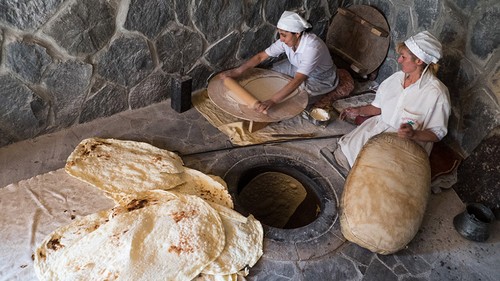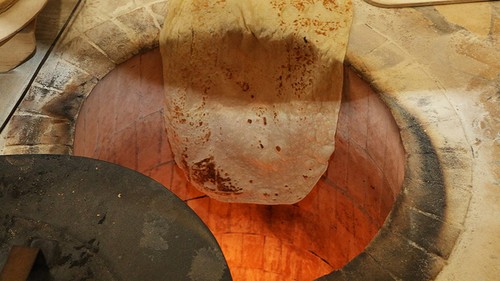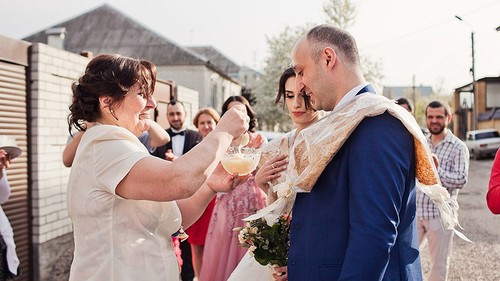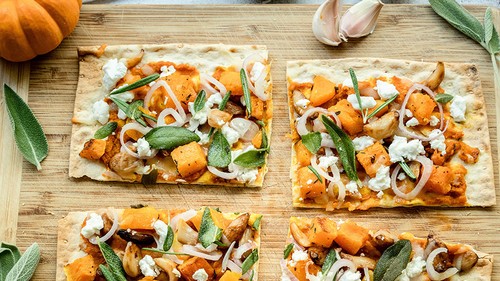 Lavash bread was added to UNESCO’s Representative List of the Intangible Cultural Heritage of Humanity in 2014 p. (Photo: wildarmenia.com) Lavash bread was added to UNESCO’s Representative List of the Intangible Cultural Heritage of Humanity in 2014 p. (Photo: wildarmenia.com) |
Lavash is a simple bread, made from flour, water, and salt. While some versions of lavash are unleavened, most are leavened using an “old dough" method, where a small portion of each batch of dough is set aside to inoculate the next one. It is essentially a form of sourdough.
Anna Salome, the Brand Manager of Tsirani Garden Restaurant in Yerevan, the capital and largest city of Armenia, explained what makes lavash bread an integral part of Armenian cuisine and culture.
According to Anna, “What makes lavash preparations special is that it’s trusted to be made by Armenian ladies, but not everyone can make lavash.”
“Preparing lavash requires a lot of physical strength and energy. A lavash maker puts her energy, her love, and care into making lavash, so she can transfer that positivity to the guests who taste it,” she added.
In addition, this has a sacred meaning, since a woman in Armenian culture is considered the household guardian, said Anna.
As lavash making is only done by women in groups, each person takes on a single part of the process. Men participate in by building the ovens and making the cushions, but they aren't usually involved in the actual baking of the bread.
 A tonir - an earthenware clay-made oven in the ground - a traditional tool used to bake lavash. A tonir - an earthenware clay-made oven in the ground - a traditional tool used to bake lavash. |
Traditional Armenian lavash is baked in a tandoor oven, giving it a unique taste and texture: bubbly, soft, and crunchy, and infused with wood smoke. The dough is rolled out flat and slapped against the hot interior wall of a clay oven. The dough adheres to the surface of the oven, cooks very quickly, and is peeled off when done, as Anna described the process.
“To make lavash, you need only flour, water, and salt. They let the dough rise, and then divide it into small balls, about 30 to 40 balls per batch. After that, it goes into an tonir built into the ground, and that’s how they make an Armenian lavash.”
“We have professional artisan bakers who make large amounts of lavash because we have a lot of tourists visiting the garden, and their first wish is to taste our freshly baked lavash.”
The bakers thinly roll out each ball of dough and place it over a large cushion, which is used to slap the dough against the wall of the hot tonir, or clay oven. The lavash bakes and bubbles in the tonir for a matter of seconds before it’s removed using an iron rod with a hook. The result is an oval-shaped flatbread that is about 70 centimeters long.
In Armenian villages, dried lavash is stored in stacks. When the time comes to eat the bread, it’s sprinkled with water to make it soft again.
Throughout Armenia you’ll see Armenian women making and selling lavash in restaurants and markets.
 According to Armenian traditions, the newlyweds’ shoulders are covered with lavash when they enter their house as a symbol of well-being and fertility. (Photo credit: Кертог/WikiCommons) According to Armenian traditions, the newlyweds’ shoulders are covered with lavash when they enter their house as a symbol of well-being and fertility. (Photo credit: Кертог/WikiCommons) |
Ms. Vera is the owner of a lavash bread shop at Gumi Shuka, one of Yerevan’s largest food markets, where about 15 to 20 women sell the lavash they’ve made in their homes.
She said she and other women at the market have been bringing lavash from Garni and Geghard to our Armenian market for more than 20 years.
“And I love it. Who can live without bread? No one! These are some tasty, aromatic, beautiful, fresh lavash. We have both dry and soft lavash. When a customer comes, they usually buy soft lavash. Whoever needs dry lavash, we’ll sell them dry. Whoever needs soft lavash, we’ll sell them soft,” said Vera.
To enjoy lavash while it’s soft, eat soon after baking. This bread dries out quickly and often becomes brittle and difficult to chew. If you don't plan to eat it immediately, freeze it in a resealable plastic bag as soon as it cools to room temperature. It will keep for up to a month.
 Lavash is served in various ways. Lavash pizza is an example. Lavash is served in various ways. Lavash pizza is an example.(Photo credits: Atoria’s Family Bakery)
|
You can eat lavash on its own or with some cheese, or wrap it around kebab or khorovats, another name for barbecue, or dip dry lavash into a bowl of khash, a traditional soup made from boiled cow hooves.
Dry lavash is crushed into the broth and covered with a large piece of lavash. Khash covered with lavash remains hot for a long time. Then, using a piece of lavash you can eat the soup, the lavash serving as a spoon.
However you choose to eat it, no Armenian dinner is complete without lavash.